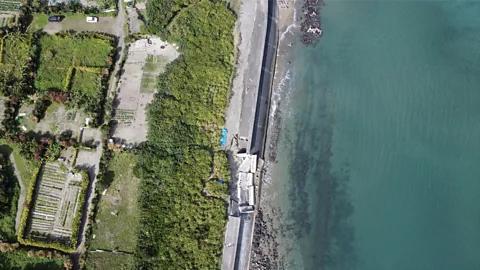Locals also express concern about their lack of involvement in the decision-making process of the seawall. The Kagoshima Prefecture conducted surveys, including environmental studies, and three rounds of expert meetings from 2016-18, but Takaaki Kagohashi, a lawyer and longtime member of Jelf involved in the court case, says local residents were not consulted, except for the then-village-chief. The BBC contacted Kagoshima Prefecture but received no comment.
Shigeo Sakae, the current village chief of Katoku since April 2023, was not aware of the details of the seawall project. “I was asked by the prefecture if I support a construction that protects the residents, so I said yes,” he says. Katoku, he adds, is the only village on the island that has not yet built any hard coastal structures until this seawall project. “All other villages have already completed their construction, but we are the only ones who haven’t had anything done for us.”
Kamata Naruhito, the mayor of Setouchi town, says projects like the seawall are needed to revitalise the economy. “Amami Oshima island has been recognised as a natural heritage site, so it is something very important that we must cherish and pass on to the next generation,” he says. “However, alongside that… public works projects are also necessary with the support of the central government.”
The cost of concrete
With intensifying typhoons and rising sea levels around the world, the tensions over the Katoku beach seawall will not be the last debate to emerge over the best way to protect local communities from flooding and coastal erosion.
Seawalls have long been considered a primary solution for coastal protection, particularly against storm surges and erosion. Hard coastal protection measures such as dikes, embankments, seawalls and surge barriers are now widespread, providing predictable levels of safety in many coastal cities and deltas around the world, according to a 2019 report from the Intergovernmental Panel on Climate Change (IPCC).
But these measures can come with a heavy cost both economically and environmentally, says Satoko Seino, associate professor at the department of ecological engineering at Kyushu University, Japan, who studies coastal seafloors.
“Concrete seawalls not only demand heavy investment but also incur ongoing maintenance costs,” says Seino. Kominato beach, which lies next to Katoku on Amami Ōshima, once shared a similar landscape with a pristine sand beach supporting both human and wildlife. With construction projects including renovation and reconstruction of breakwaters, embankments, wharves, boat ramps, roads and land development totalling some 5.32 billion yen (£27m/ $34m) since the 1970s, parts of Kominato beach are now littered with neglected concrete.
Edward Atkin, director of eCoast Marine Consulting and Research in New Zealand, has studied Kominato beach and compared it with Katoku. In a 2021 assessment, he concluded that the Kominato seawalls exacerbated erosion and shortened the beach width, while the seawall itself has also been eroded by sea water. He noted that both Kominato and Katoku beaches had the same “pocket beach” structure, where the beach holds a closed off and highly sensitive sand system that moves around under different wave conditions.
 katoku.org
katoku.org